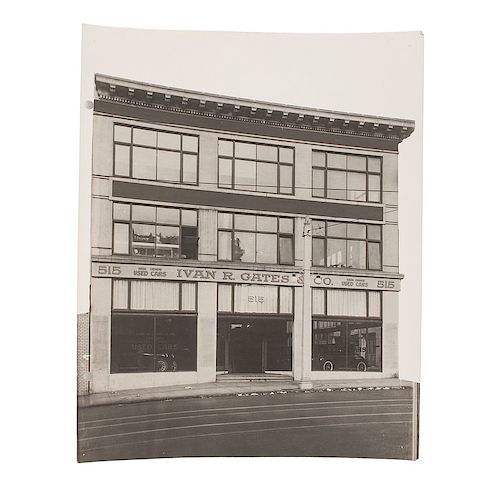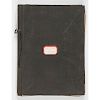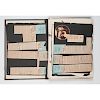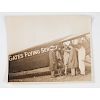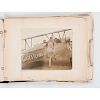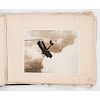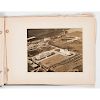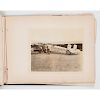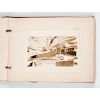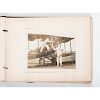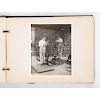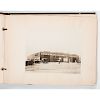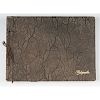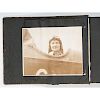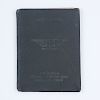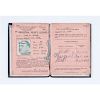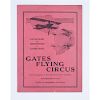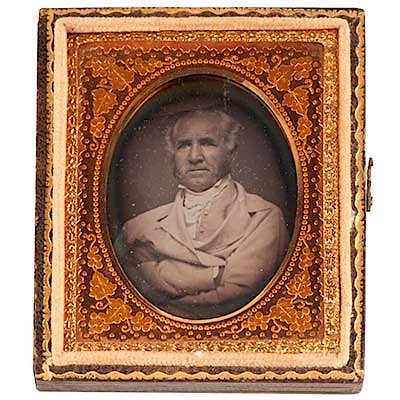Aviation Pioneer Ivan R. Gates, Personal Photograph and Document Archive of the Gates' Flying Circus Founder
About Seller
6270 Este Ave.
Cincinnati , OH 45232
United States
With offices in Cincinnati, Cleveland and Denver, Cowan’s holds over 40 auctions each year, with annual sales exceeding $16M. We reach buyers around the globe, and take pride in our reputation for integrity, customer service and great results. A full-service house, Cowan’s Auctions specializes in Am...Read more
Two ways to bid:
- Leave a max absentee bid and the platform will bid on your behalf up to your maximum bid during the live auction.
- Bid live during the auction and your bids will be submitted real-time to the auctioneer.
Bid Increments
| Price | Bid Increment |
|---|---|
| $0 | $25 |
| $500 | $50 |
| $1,000 | $100 |
| $2,000 | $250 |
| $5,000 | $500 |
| $10,000 | $1,000 |
| $20,000 | $2,500 |
| $50,000 | $5,000 |
| $100,000 | $10,000 |
About Auction
Nov 16, 2018
Cowan’s Fall American History: Premier Auction features over 200 lots including early photographs, documents, manuscripts, broadsides, flags, and more dating from the Revolutionary War period to the mid-20th Century, many representing important landmark moments in American history. Cowan's Auctions dawnie@cowans.com
- Lot Description
Ivan R. Gates was born in 1890 in Rockford, Michigan. At the age of 19 he moved to Los Angeles and became an automobile salesman. Shortly thereafter, he became interested in aviation and moved to San Francisco to open an automobile brokerage house. By 1911, he had purchased a bi-plane and received one of the earliest pilot's licenses. A serious automobile accident grounded him for a time, but he met French pilot and mechanic Didier Masson. Masson refused to fly the bi-plane Gates had acquired, so "Van" set out to design and build his own plane. The focus became stability and soundness to satisfy Masson. These characteristics became central in later Gates designs. Ultimately, Gates planes would carry a million passengers with the loss of only one life, and that through pilot error, not aircraft failure.
Gates toured back East in one of his own planes in 1912. He started his first air works in San Francisco in 1913 and established the first West Coast flying school shortly thereafter. All the while he was still in the automobile business to raise enough money to continue in aviation and engaged in auto racing, both staging races and participating in them. When the war broke out, he joined the armed forces, with an interest in the Army Air Corps, but before he could finish training and get to Europe, the armistice was in place. While waiting for a place in the Air Corps, he staged a number of Air meets, using the profits to supply sweaters, helmets, gloves to military pilots.
After the war, he formed the Gates Flying Circus, to show off the early pilots and daredevils of the air. Along with these demonstrations were often air meets / races. In the process, he helped to develop many airports around the country, so the planes could land somewhere other than a cornfield. This also helped the nation see the potential of commercial aviation. In 1927, he saw that the days of the Flying Circus were over, so with Charles Day, he founded Gates-Day Aviation Company. They started by updating the Army's aircraft trainer, then went on to design and build dozens of advanced aircraft. At the end of 1928, the name was changed to the New Standard Aircraft Company. The onset of the Great Depression seriously damaged the business, which went bankrupt in 1931. Gates tried art exhibits, but that venture met with little success. Despondent over the company's bankruptcy, and after a fight (one of many, by some reports) with his wife on Thanksgiving Day, 1932, he told her he was going to jump out of the 6th floor apartment window, then proceeded to do just that. He was cremated and his ashes scattered to the wind from an airplane over Holmes Airport, Jackson Heights (Queens, NY), by fellow flyers at his request.
This group of items includes:
Gates' Industrial Pilot's License, issued 16 August 1929, with three renewals. In approx. 3 x 4 in. brown folder, with U.S. Department of Commerce imprint on front.
Gates Flying Circus, Catalogue and Description of Exhibitions. 8 x 11 in. booklet with printed paper wraps. This is a catalog for those putting together air shows, with examples of the programs they could organize with the Gates flyers.
Menus for luncheons and dinners: Luncheon ...to commemorate the second Anniversary of Clarence D. Chamberlin's Atlantic Flight, New York to Germany, June 4,5,6th 1927, 8 x 12 string-tied folder; The Early Birds An Association of Aerial Pioneers who Piloted During the First Thirteen Years of Flight, Hotel St. Regis, New York, Feb. 7, 1929, 6.25 x 9.25 in. card; and Progress Dinner of United Business Interests to the Aviation Industry, Hotel Commodore, New York, January 29, 1929, 8.5 x 11 in. folder.
Air Transportation: The Trade Journal of Commercial Aviation. Vol. 11, No. 12, April 5, 1930. With a one-page tribute to Gates (p. 26). Complete issue. There are 11 more single pages from this journal in the folder with the Gates article.
Ad for the Gates Flying Circus from October 1925. Interestingly, verso with ad for Sikorsky. In the Air Transportation edition, one also finds names that are still in aviation today - McDonnell, Boeing, Lockheed - as well as classics such as Curtiss-Wright.
Typed biography of Ivan Gates, written while he was still active in aircraft design, 8pp.
Manuscript journal of cross-country tour, 19 pp, on hotel stationery. This seems to be in the hand of Mrs. Gates, since she refers to "Van" in the 3rd person. First 10 pages on The Commodore Perry, Toledo, Ohio paper. Dated 9/7/28. "Took off from Teteboro Airport 2:15 PM after waiting for the ship (Topper Universal) to be finished and tested. There are six of us. We are following the mail route to Chicago....Sept-8-1928. First call at 3:45 A.M., arrived at field at 5 A.M. 50 gals of gas. Started to take off at 5:50 but cut the gun and waited on account of a thick ground fog rolling in... 7:14 Out one hour. Geo. has had his nap. Nice & clear now & Making about 100 miles an hour and 4,000 feet up....8:15 Are flying about six miles inland from Lake Michigan now. Can see the Lake, but it is rather hazy. Van is up in the pilot's cockpit now. Think he is flying the ship.... 8:50 Landed at wrong field. Got directions to air mail field from motorist..." The next two pages are on The Plains Hotel, Cheyenne, Wyoming stationery. "9:10 (Sept 9) Passing over more mts. rather bumpy. Still following the mail route & mail plane. Up about 8500 feet. Quite cold...." Then six more pages on The Newhouse Hotel stationery, Salt Lake City, Utah. "Sept. 10... Left Salt Lake City at 12:06 with an extra passenger for Miner Field Los Angeles. Stayed in Salt Lake to demonstrate ship...."
There are 12 sketches of nudes and cartoons, some of which are somewhat pornographic and would seem to stem from Gates' art gallery days.
Four photo albums, three with typed label on front "Personal Property of Ivan R. Gates." There are 12 loose 8 x 10 in. photos with blindstamp of Gates Flying Circus, about half showing George Babcock wing-walking. Some with adhesive residue on verso. The first album has 21 more 8 x 10 images, some also with the Flying Circus blindstamp, some with "Gates Flying Service" along the body of the plane and many with adhesive residue.
The second album has 45 more 8 x 10s, five 11 x 14 in. photos, 9 post-card sized images and 4 more of various sizes (3 are approx. 5 x 7 in.).
The third album has two 11 x 14s, 59 - 8 x 10s, four 5 x 7s, and one 3 x 4.5. Most of these show the Gates Aircraft Company building and factory. Some show aircraft construction, a few with planes surrounded by men in white jump suits, and some with executives in front of a plane.
The fourth does not have the typed label. It is an obl. 11 x 15 in. photograph book, pages of black "construction paper," about half unused. The pages that do have the 21 -8 x 10 in. photos are all separated from the book with chipping of the black paper. The photos are fine, however.
- Shipping Info
-
Buyers are required to pay for all packing, shipping and insurance charges. Overseas duty charges are the responsibility of the successful Bidder. Be aware that for larger and/or valuable items, shipping charges can be substantial. - If there is no shipping amount on listed your invoice, you will need to make arrangements to pick up or ship your purchase through an alternative shipping company. Our shipping department can be contacted at 513.871.1670 (ext. 219) or email shipping@cowans.com. - Shipping charges include insurance for your order while in transit. If you have private insurance we will adjust your charge to include only packing and shipping. - Please allow 14 – 21 days after payment to package and ship your purchase as carefully as possible.
-
- Buyer's Premium



 EUR
EUR CAD
CAD AUD
AUD GBP
GBP MXN
MXN HKD
HKD CNY
CNY MYR
MYR SEK
SEK SGD
SGD CHF
CHF THB
THB